Partial Response Pattern in Java: Optimizing Data Delivery for Efficient Web Services
Also known as
- Incremental Response
- Partial Result
Intent of Partial Response Design Pattern
To enable an application to return a partial response to a client, improving perceived performance and enabling the client to start processing parts of the data before the entire response is available.
Detailed Explanation of Partial Response Pattern with Real-World Examples
Real-world example
Imagine a restaurant where a customer orders a multi-course meal. Instead of waiting until all courses are prepared before serving, the restaurant brings out each dish as soon as it's ready. This allows the customer to start enjoying the meal without delay, improves the dining experience, and optimizes the kitchen's workflow by letting them prepare and serve courses incrementally. Similarly, in software, the Partial Response design pattern delivers portions of data as they become available, allowing the client to begin processing immediately and improving overall performance and responsiveness.
In plain words
The Partial Response design pattern allows a system to send portions of data to the client as they become available, enabling the client to start processing the data before the complete response is received.
Sequence diagram

Programmatic Example of Partial Response Pattern in Java
The Partial Response design pattern allows clients to specify which fields of a resource they need. This pattern is useful for reducing the amount of data transferred over the network and allowing clients to start processing data sooner.
The programmatic example shows a simple video streaming application.
Video class represents a video object with several fields.
public class Video {
private String id;
private String title;
private String description;
private String url;
// Getters and setters...
}FieldJsonMapper utility class converts video objects to JSON, including only the requested fields. Method mapFields takes a Video object and a set of field names. It creates a JSON object including only the specified fields. The ObjectMapper from Jackson library is used to build the JSON object.
public class FieldJsonMapper {
private static final ObjectMapper mapper = new ObjectMapper();
public static ObjectNode mapFields(Video video, Set<String> fields) {
ObjectNode node = mapper.createObjectNode();
if (fields.contains("id")) {
node.put("id", video.getId());
}
if (fields.contains("title")) {
node.put("title", video.getTitle());
}
if (fields.contains("description")) {
node.put("description", video.getDescription());
}
if (fields.contains("url")) {
node.put("url", video.getUrl());
}
return node;
}
}VideoResource class handles HTTP requests and returns only the requested fields of the video data.
- The
VideoResourceclass is a RESTful resource handling HTTP GET requests. - The
getVideomethod fetches aVideoby its ID and processes thefieldsquery parameter. - It splits the
fieldsparameter into a set of field names, usesFieldJsonMapperto include only those fields in the response, and returns the partial JSON response.
@Path("/videos")
public class VideoResource {
@GET
@Path("/{id}")
@Produces(MediaType.APPLICATION_JSON)
public Response getVideo(@PathParam("id") String id, @QueryParam("fields") String fieldsParam) {
Video video = findVideoById(id); // Assume this method fetches the video by ID
Set<String> fields = new HashSet<>(Arrays.asList(fieldsParam.split(",")));
ObjectNode responseNode = FieldJsonMapper.mapFields(video, fields);
return Response.ok(responseNode.toString()).build();
}
private Video findVideoById(String id) {
// Dummy data for demonstration purposes
Video video = new Video();
video.setId(id);
video.setTitle("Sample Video");
video.setDescription("This is a sample video.");
video.setUrl("http://example.com/sample-video");
return video;
}
}App class initializes the web server and registers the VideoResource.
- The
Appclass sets up the server using Jersey. - It registers the
VideoResourceclass, which will handle incoming HTTP requests. - The server listens on
http://localhost:8080/.
public class App {
public static void main(String[] args) {
ResourceConfig config = new ResourceConfig();
config.register(VideoResource.class);
SimpleContainerFactory.create("http://localhost:8080/", config);
}
}To summarize, in this example:
- The
Videoclass defines the video data structure. - The
FieldJsonMapperclass helps create JSON responses including only the requested fields. - The
VideoResourceclass processes client requests, fetching the necessary video data and returning partial responses based on the specified fields. - The
Appclass configures and starts the web server.
By implementing the Partial Response design pattern, clients can request only the necessary data, enhancing performance and reducing bandwidth usage.
When to Use the Partial Response Pattern in Java
Use the Partial Response pattern when
- Utilize the Partial Response pattern when dealing with large data sets or APIs that require improved load time and performance.
- When it’s beneficial for the client to begin processing the data as it arrives rather than waiting for the complete response.
- In APIs where different clients might need different subsets of data, allowing them to specify what they need.
Real-World Applications of Partial Response Pattern in Java
This pattern is widely adopted in
- RESTful APIs allowing clients to specify fields they want using query parameters.
- Streaming large datasets where initial parts of the data can be sent immediately (e.g., video streaming).
- GraphQL queries where clients can request only specific fields to be returned.
Benefits and Trade-offs of Partial Response Pattern
Benefits:
- Improved Performance: Reduces wait time for the client by allowing it to start processing data as soon as it begins to arrive.
- Resource Optimization: Decreases server load and bandwidth usage by sending only the required data.
- Scalability: Enhances system scalability by handling large datasets more efficiently and reducing the likelihood of timeouts.
Trade-offs:
- Complexity: Increases the complexity of both client and server implementations to handle partial responses properly.
- Error Handling: May complicate error handling and recovery if only parts of the data are received correctly.
- State Management: Requires careful management of state, especially if the partial responses are to be processed incrementally.
Related Java Design Patterns
- Asynchronous Messaging: Often used together with asynchronous messaging patterns to handle partial responses without blocking the client.
- Caching: Can be combined with caching patterns to store partial responses and avoid redundant data transfers.
- Proxy: The proxy can intercept requests and manage partial responses, providing a buffer between the client and server.